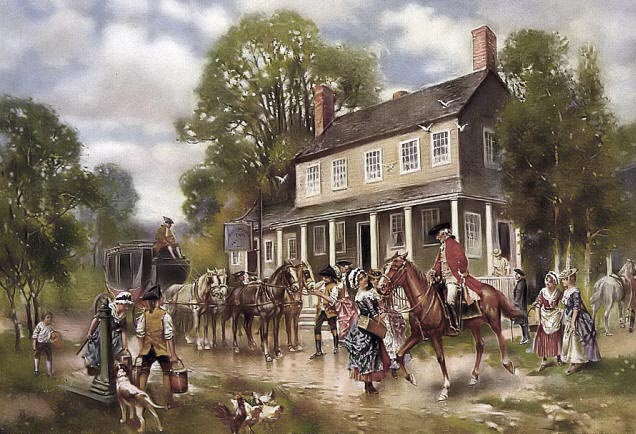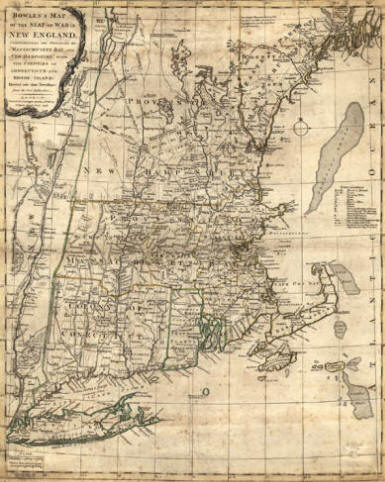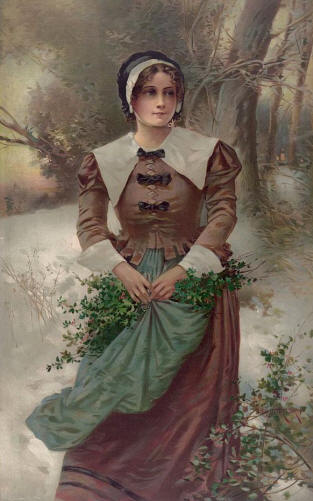New England
|
|
This Site:
|
Colonial New England New England. Sir Humphrey Gilbert (1583) and Bartholomew Gosnold (1602) visited the New England coast, and the latter planted a temporary colony there. The account given by Gosnold excited desires on the part of friends of Sir Walter Raleigh to make new efforts to found settlements in America, especially in the northeastern parts. Richard Hakluyt, who was learned in naval and commercial science (see HAKLUYT, RICHARD), Martin Pring, and Bartholomew Gosnold, all friends of Raleigh, induced merchants of Bristol to fit out two ships in the spring of 1603 to visit the coasts discovered by Gosnold. Early in April (a fortnight after the death of Queen Elizabeth), the Speedwell, of 50 tons, and the Discoverer, 26 tons, sailed from Milford Haven under the command of Pring, who commanded the larger vessel in person. William Browne was master of the Discoverer, accompanied by Robert Galterns as supercargo or general agent of the expedition. They entered Penobscot Bay early in June, and went up the Penobscot River some distance; then, sailing along the coast, they entered the mouths of the Saco and other principal streams of Maine; and finally, sailing southward, they landed on a large island abounding with grapes, which they named Martin's (corrupted to Martha's) Vineyard.
Then the anchor was raised, the vessel sailed to England, and three of the captives were given to Sir Ferdinando Gorges, governor of Plymouth. This outrage left on the shores of New England the seeds of much future trouble with the natives. By these voyages and explorations all doubts about the commercial value of every part of North America were definitely settled, and led to the almost immediate execution of a vast plan for colonizing the shores of the Western Continent by obtaining from King James I. a patent for a domain extending from lat. 34° to 45° N. This territory was divided, and two companies were formed to settle it - one called the "London Company," and the other the "Plymouth Company." The latter company, destined to settle the northern portion, possessing much narrower resources than the other, its efforts were proportionably more feeble and inadequate. Some visits to and slight explorations of the region were made during six or seven years by the Plymouth Company after obtaining their charter, but discouragements ensued. At length the restless Captain Smith, who did not remain long idle after his return from Virginia in 1609, induced four London merchants to join him in fitting out two ships for the purpose of discovery and traffic in northern Virginia, the domain of the Plymouth Company. With these ships Smith left the Downs at the beginning of March, 1614, Captain Thomas Hunt commanding one of the vessels, and he the other. They first landed on Mohegan Island, 20 miles south of the mouth of the Penobscot River, where they sought whales but found none. Leaving most of the crew to pursue ordinary fishing, Smith had seven small boats built, in which he and eight men ranged the coast from Penobscot eastward and westward. They went as far south as Cape Cod, bartering with the natives for beaver and other furs. They went up the several rivers some distance in the interior, and after an absence of seven months the expedition returned to England. From his observations of the coasts, islands, and headlands, Captain Smith constructed a map, which he laid before Prince Charles (afterwards Charles I.), a young man of considerable literary ability and artistic taste. Sir Francis Drake had given the name of New Albion (New England) to the region of the continent which he had discovered on the Pacific coast, and the region now discovered by Smith on the Atlantic coast, opposite Drake's New Albion, was, out of respect to that great navigator, called " New England," or New Albion. It has been so called ever since. It includes the country from 20 miles east of the Hudson River and the eastern shores of Lake Champlain to the eastern boundary of the United States, and includes the States of Maine, New Hampshire, Massachusetts, Rhode Island, Connecticut, and Vermont. Smith named the promontory at the north entrance to Massachusetts Bay Tragabigzanda, in compliment to a Turkish lady to whom he had been a slave in Constantinople. Prince Charles, however, in filial regard for his mother (Anne of Denmark), named it Cape Anne. Smith gave his name to a cluster of islands, which were afterwards named Isles of Shoals. These and other places, changed from names given by Smith, still retain their new names. The crime of Weymouth was repeated on this expedition. Captain Smith left Hunt, an avaricious and profligate man, to finish the lading of his vessel with fish, and instructed him to take the cargo to Malaga, Spain, for a market. Hunt sailed along the New England coast, and at Cape Cod he enticed a chief named Squanto and twenty-six of his tribe on board his vessel and treacherously carried them to Spain, where all but two of them were sold for slaves. Some benevolent friars took them to be educated for missionaries among the Indians, but only two (one of them Squanto) returned to America. The natives on the New England coast were greatly exasperated; and when, the same year, another English vessel came to those shores to traffic, bringing with them the two kidnapped natives, the latter united with their countrymen in a measure of revenge. In twenty canoes the Indians attacked the Englishmen with arrows, wounding the master of the ship and several others of the company, and the adventurers hastened back to England. The natives of New England long remembered these outrages.
Expansion and aggression were two conspicuous characteristics of the New England colonists. The Plymouth people early sought to plant outlying settlements on the Eastern coasts; and after the beautiful country along Long Island Sound, west of the Pequod (Thames) River, was revealed to the New-Englanders, they planted a settlement at New Haven and, pushing westward, crowded the Dutch not only on the mainland, but on Long Island. In 1639, Lewis Gardiner purchased an island still known as Gardiner's Island, at the east end of Long Island; and James Farrett, sent out by the Earl of Stirling (see ALEXANDER, SIR WILLIAM) , took possession of Shelter Island, near by, at the same time claiming the whole of Long Island. In 1640 a company from Lynn, Mass., led by Capt. Daniel Howe, attempted a settlement at Cow Neck, in North Hempstead, Long Island, when they tore down the arms of the Prince of Orange which they found upon a tree, and carved in place of the shield a grinning face. Howe and his companions were driven off by the Dutch, and settled on the eastern extremity of Long Island. Some New Haven people took possession Of Southold, on the Sound; and only a few years later, Hempstead, Jamaica, Flushing, Southampton, East Hampton, Brookhaven, Huntington, and Oyster Bay were settled by the English and some of them were united to Connecticut politically, until after the surrender of New Netherland to the English in 1664, when all Long Island came under the jurisdiction of NEW YORK . In 1640 a New England captain purchased some land on the Delaware River of the Indians. Early the next spring colonists from New England, led by Robert Cogswell, sailed from the Connecticut for the Delaware in search of a warmer climate and more fertile soil. They lay for a few days at Manhattan, when they were warned not to encroach upon New Netherland territory. The English, according to De Vries, " claimed everything "; and these New-Englanders went on and had no trouble in finding Indians to sell them "unoccupied lands." Indeed, the Indians were ready to sell the same lands to as many people as possible. At the middle of the summer they had planted corn and built trading-posts on Salem Creek, N. J., and near the mouth of the Schuylkill in Pennsylvania. Both settlements prospered, and the New Haven colony took them under their protection. They came to grief in the spring of 1642. The intrusion of the New Englanders was as distasteful to the Swedes on the Delaware as to the Dutch; and when the Dutch commissioner at Fort Nassau was instructed by Governor Kieft to expel them, the Swedes assisted the Dutch with energy. The New-Englanders yielded without resistance. They were carried prisoners to Manhattan, and thence sent home to Connecticut. In 1644 a vessel was fitted out by a Boston company, and ascended the Delaware in search of the great interior lakes of which rumors had reached Massachusetts, and whence they supposed much of the supply of bear-skins was derived. The vessel was closely followed by two pinnaces, one Dutch and the other Swedish. The New-Englanders were forbidden to trade with the Indians, and the vessel was not allowed to pass the Swedish fort. Thus excluded from the Delaware, the New-Englanders approached the Hudson River, by establishing a trading-post on the Housatonic, nearly 100 miles from the Sound. Governor Andros, appointed by James II. president of New England, exercised his powers in a tyrannous manner. He, with his council, made laws and levied taxes at their pleasure. Without the voice of an assembly, they levied a penny on the pound on all the estates in the country, and another penny on all imported goods, besides 20d. per head as poll - tax, and an immoderate excise on wine, rum, and other liquors. In many towns the inhabitants refused to levy the assessments; and as this was construed by the tyrant as seditious, punishments were inflicted. The selectmen of Ipswich voted, in 1688, " That inasmuch as it is against the privilege of English subjects to have money raised without their own consent in an assembly or parliament, therefore they will petition the King for liberty of an assembly before they make any rates." For this offence Sir Edmund caused them to be fined some $100, some $150, and some $250. So offensive became the government of Andros that some of the principal colonists sent the Rev. Increase Mather to England to represent their grievances to the King. His agency availed nothing, for Andros was acting under instructions from the monarch. |
|
|
||
|
|
Site Copyright 2003-2018 Son of the South. For Questions or comments about this collection, contact: paul@sonofthesouth.net |
|
|
Are you Scared and Confused? Read My Snake Story, a story of hope and encouragement, to help you face your fears. |
||


 The
magistrates and ministers, in the early days of the New England
colonies, undertook to regulate by law the morals and manners of the
people, and made statutes which today appear absurd, but were then
regarded as essential to the wellbeing of society. The
The
magistrates and ministers, in the early days of the New England
colonies, undertook to regulate by law the morals and manners of the
people, and made statutes which today appear absurd, but were then
regarded as essential to the wellbeing of society. The